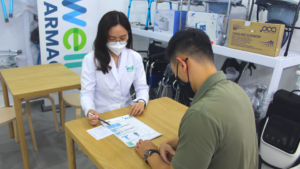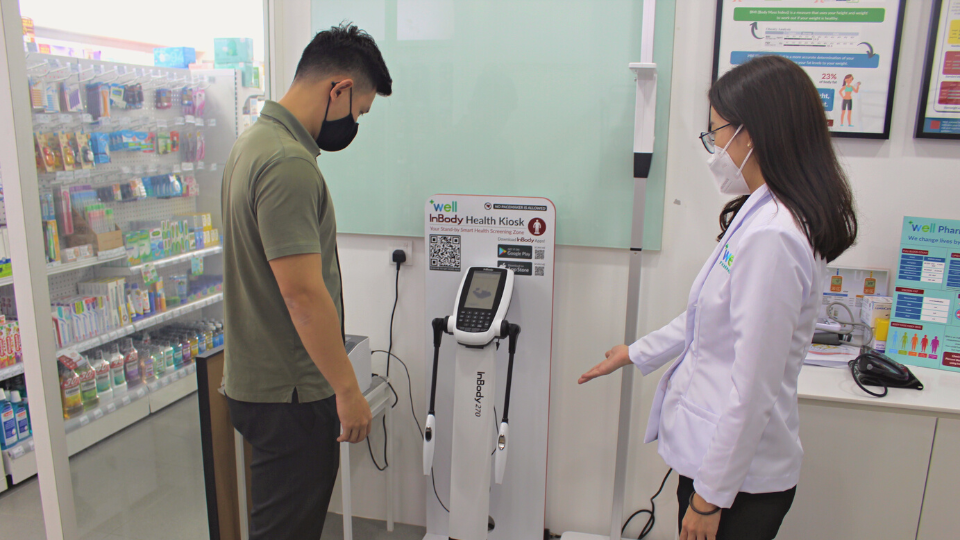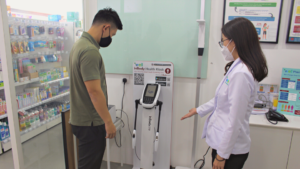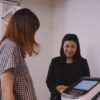When there are many different BIA devices available on the market, it can be difficult to choose. Particularly, when you’re trying to purchase your first BIA device in the hopes that it will complement your services to serve customers’ health more effectively.
An accurate BIA device could set your service apart from the competition. This step-by-step guide will help you choose the best BIA device.
BIA devices are becoming one of the most popular and convenient ways to measure body fat percentage and body composition because of their speed, convenience, and accuracy. There is no shortage of them to buy, and costs range greatly. Some are extremely affordable, while others cost upwards of tens of thousands.
Why? What’s the difference between them?
Fundamentally, all BIA devices operate using the same method: a small, safe, electric current is sent through a person’s body. Along the way, it encounters resistance due to the variation in water content in different parts of your body – like in fat and muscle – and that resistance is measured. This information is then analyzed and translated into useful outputs, such as body fat percentage and lean body mass.
So if every device uses the same method, why the range in price? What are some things to consider when looking for a BIA device, especially those that influence the cost? Here, we’ll break down the most important things to look into when buying a BIA device to measure body composition.
Check the frequencies

All BIA devices use at least one electric current set at a specific frequency to measure body composition. In the past, this frequency was traditionally set at 50 kHz. Some devices today continue to use this single frequency.
However, the earlier research began to accumulate suggesting that single frequency devices set at 50 kHz did not accurately predict changes in total body water. The use of multiple frequencies set at a different frequencies was a superior method in terms of accuracy. So, the first thing you will want to check when looking at BIA devices whether it is a single or multifrequency device because generally speaking, devices that use multiple frequencies are found to be more accurate.
Why are multifrequency devices typically more accurate? The answer lies with how BIA devices measure that resistance – more accurately termed “impedance” – when the current travels through the body.
As the current travels, the water in your body will naturally resist the flow of the current as it travels. This is called resistance. When the current encounters a cell, the cell wall will cause a “delay” as the current builds up enough energy to pass through the cell wall. This brief “time delay” is referred to as reactance. Impedance is a combination of these two values.
How does this apply to frequencies? Lower frequencies don’t have enough energy to pass through cell walls easily, so they often follow an easier path by traveling around cells. This means lower frequencies are better suited for measuring extracellular water. Conversely, higher frequencies are better suited to penetrating cell walls and can measure both intracellular and extracellular water. The end result is that those frequencies can measure all of your body water and provide you with an accurate result for your lean body mass.

Ideally, you will want a device that uses at least two frequencies – one on the lower end and the other on the higher end. The more frequencies you have, the better the device is able to gather the information required to accurately measure your total body water, and from there, your body composition.
See what outputs it provides

BIA devices range widely in capabilities and the outputs they are able to produce. Some devices only measure your body fat percentage, while others can give much more information. Typically, the better quality the BIA device, the more comprehensive outputs you will receive.
Every BIA device on the market will at least give body fat percentage. Using body fat percentage as an indicator of your overall health and weight is a very useful metric and a much better tool than simply monitoring your scale weight.
Here are a few other BIA outputs to look for and some reasons why you would want to track these in addition to body fat:
- Skeletal Muscle Mass: Skeletal Muscle Mass is the muscle that you can grow and develop through exercise and proper nutrition. It also has a significant influence on change in Lean Body Mass. However, Lean Body Mass can also be influenced by other factors such as body water. If you are tracking Skeletal Muscle Mass, you’ll be able to cross reference your muscle gains against your Lean Body Mass to ensure that those gains are due to muscle, not water.
- Body Water Analysis: Since BIA devices all measure total body water via impedance, if your device can give you this information, you’ll know how much total body water you have. If your device can further break this down into intracellular and extracellular water components, you’ll be able to understand your body water levels are properly balanced. With that information, you’ll know if you have any unusual swelling due to inflammation, injury, etc.
- Phase Angle: Phase Angle is a measurement of the relationship between reactance, resistance, and impedance. It’s able to give you an idea of the integrity of your cell walls, which gives an indication of their ability to retain water. This has an impact on your overall health. By tracking Phase Angle, you’ll be able to get an idea about the health of your individual cells and how much water is inside them.
Find out what information it needs (important)

All BIA devices are going to require your weight at the very minimum. For this reason, many BIA devices take the form of bathroom scales. These devices measure your weight and calculate your body composition results using your weight at the time of testing.
However, not all BIA devices are scales. BIA technology is being used in handheld devices for convenience, as well as devices that use adhesive electrodes and require a person to lie down while testing. These types of devices will require a user to enter in their weight manually. However, unless you weigh yourself right before testing, this information would have to be estimated based on your memory, which could cause inaccurate results.
Another fairly common user input requirement is age or gender. However, these requirements aren’t to personalize your results; they’re to tell the device which equations to use to calculate your results. In the BIA industry, these equations are known as empirically derived prediction variables – also sometimes referred to as “empirical estimations.”
For example, the average person tends to gain body fat mass as they age. This trend has been observed over time, and equations have been developed to account for this fat gain. By entering in your age, the BIA device will compare the raw data it gets from you and adjust it based on the data it has for your age.
BIA devices often use empirical estimations to improve the accuracy of their results. They work on the basis of adjusting the raw results for an individual of your age and gender. Age and gender are common to nearly all BIA devices.
Height is also a common requirement for many BIA devices. It’s an unbiased physical attribute, just like weight. Unlike age and gender, however, height is necessary not because adjustments need to be made to results, but instead to give the BIA device a frame to understand the impedance results.
Impedance increases as height increases because the current has to physically travel further and will encounter more resistance. However, high impedance is also associated with a greater proportion of fat mass to lean body mass. With accurate height measurements, the BIA device will understand how to interpret the impedance values correctly, which is why nearly all BIA devices require height measurements.
Understand what’s measured and what’s not

The design of many BIA devices are such that impedance is measured for a certain section of the body, and the results of that section are used to estimate the remaining sections of the body. Before choosing a BIA device, you should know what exactly your device is measuring and what it is estimating.
Home scales that use BIA technology to determine body composition operate by sending currents up one leg and down the other. Impedance is only actually measured for the legs. In order to calculate the upper body, the device will make assumptions about the composition of your body based on the composition of your legs (and if using age and gender data, adjusting for those as well).
Handheld BIA devices only measure impedance in the arms and upper body. Similar to how the legs are measured, these types of BIA devices will estimate the lower half of the body with the results from the upper body.
Other devices that use the “Whole Body” impedance use a method that is somewhat misleading. Unlike scales and handheld devices, the current does travel through the entire body in the sense that it travels from through both the upper and lower body. However, “Whole Body” impedance devices do not actually directly measure the entire body. Typically, “Whole Body” impedance devices get most of their measurement data from the arm and leg that the electrodes are placed on. Just like handhelds and scales, these devices must estimate results for the rest of the body.
Finally, there are devices that use Direct Segmental Multifrequency-BIA technology (DSM-BIA). These devices programmed in such a way that they analyze your body in five distinct sections – the two arms, the two legs, and the torso.
Each of these sections is analyzed independently, and from these, a measurement for the entire body is produced. This is similar to how DEXA machines operate, and when compared against DEXA results, DSM-BIA technology was found to be accurate. In comparison to other BIA methods, DSM-BIA offers results that are based on direct measurements, without using estimations to compensate for the areas that were not directly measured.
Summary
There are a lot of things to consider when looking for a BIA device. When you’re assessing which device to go with, it will help you to remember the following:
- Accuracy generally will increase with multi-frequency devices. You’ll want at least two frequencies for reliable measurements.
- You can do more with more results. Changes in body fat percentages can be tricky to explain if the only outputs you have are Fat and Fat Free Mass.
- Check what information the device needs from you in order to test. If it requires your age and/or gender, it may be giving you estimations based on the results of the general population.
- Understand what the device is actually measuring and what it is estimating. If accuracy is important to you, you’ll want as much of the body measured as possible.
Contact us to learn which BIA models are best for you.


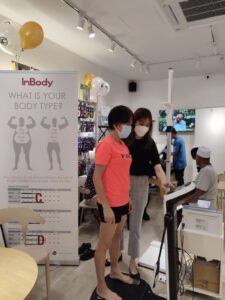 For the body composition analysis, Farmasi Chong Alma understands the importance of providing their community with more accurate and insightful health assessments, and delightfully, they have chosen InBody, a body composition analyzer that can precisely measure their customers’ body composition and help their nutritionists and dietitians to identify any underlying health risk of their customers.
For the body composition analysis, Farmasi Chong Alma understands the importance of providing their community with more accurate and insightful health assessments, and delightfully, they have chosen InBody, a body composition analyzer that can precisely measure their customers’ body composition and help their nutritionists and dietitians to identify any underlying health risk of their customers.






